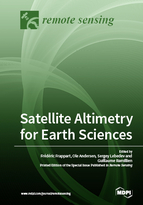Satellite Altimetry for Earth Sciences
A special issue of Remote Sensing (ISSN 2072-4292).
Deadline for manuscript submissions: closed (28 February 2018) | Viewed by 141908
Special Issue Editors
Interests: remote sensing; water cycle; carbon cycle; wetlands
Special Issues, Collections and Topics in MDPI journals
Interests: marine geophysics; oceanography; hydrology and surface water storage; fresh water flux; height system; geoid; gravity; bathymetry
Interests: regional and global climatic change; the Caspian Sea level and dynamic; water level of rivers, lakes and reservoirs; gravity field
Interests: marine geophysics; oceanography; hydrology and surface water storage; fresh water flux; height system; geoid; gravity; bathymetry
Special Issues, Collections and Topics in MDPI journals
Special Issue Information
Dear Colleagues,
Satellite altimetry is a radar technique for measuring the topography of the Earth’s surface. It was initially designed for measuring the ocean’s topography, with reference to an ellipsoid, and for the determination of the marine geoid. Satellite altimetry has provided extremely valuable information on ocean science (e.g., circulation surface geostrophic currents, eddy structures, wave heights, and the propagation of oceanic Kelvin and Rossby waves). With more than 25 years of observations, it is also becoming vital to climate research, providing accurate measurements of sea level variations from regional to global scales. Altimetry has also demonstrated a strong potential for geophysical, cryospheric and hydrological research, and is now commonly used for the monitoring of Arctic and Antarctic ice sheet topography, and of terrestrial surface water levels. This Special Issue aims to present reviews and recent advances of general interest in the use of radar altimetry in Earth sciences. Manuscripts can be related to any aspect of radar altimetry technique or geophysical applications. We also encourage manuscript resulting from application of new altimetric technology (SAR, SARin and Ka band) and improvements expected from missions to launched in the close future (i.e., SWOT).
Dr. Frederic Frappart
Dr. Ole Andersen
Dr. Sergey Lebedev
Dr. Guillaume Ramillien
Guest Editors
Manuscript Submission Information
Manuscripts should be submitted online at www.mdpi.com by registering and logging in to this website. Once you are registered, click here to go to the submission form. Manuscripts can be submitted until the deadline. All submissions that pass pre-check are peer-reviewed. Accepted papers will be published continuously in the journal (as soon as accepted) and will be listed together on the special issue website. Research articles, review articles as well as short communications are invited. For planned papers, a title and short abstract (about 100 words) can be sent to the Editorial Office for announcement on this website.
Submitted manuscripts should not have been published previously, nor be under consideration for publication elsewhere (except conference proceedings papers). All manuscripts are thoroughly refereed through a single-blind peer-review process. A guide for authors and other relevant information for submission of manuscripts is available on the Instructions for Authors page. Remote Sensing is an international peer-reviewed open access semimonthly journal published by MDPI.
Please visit the Instructions for Authors page before submitting a manuscript. The Article Processing Charge (APC) for publication in this open access journal is 2700 CHF (Swiss Francs). Submitted papers should be well formatted and use good English. Authors may use MDPI's English editing service prior to publication or during author revisions.








